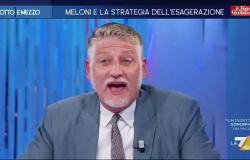Title: The Animal Kingdom
Original title: The Animal Kingdoms
Direction: Thomas Cailley
Country of production / year / duration: France / 2023 / 128 min.
Film script: Thomas Cailley, Pauline Munier
Photography: David Cailley
Assembly: Lilian Corbeille
Music: Andrea Laszlo De Simone
Sound: Fabrice Osinski, Raphael Sohier, Matthieu Fichet, Nicolas Becker, Niels Barletta
Cast: Romain Duris, Paul Kircher, Adèle Exarchopoulos, Tom Mercier, Billie Blain, Xavier Aubert, Saadia Bentaïeb, Gabriel Caballero, Iliana Khelifa, Paul Muguruza, Nathalie Richard, Louise Lehry, Jean Boronat, Nicolas Avinée
Production: Nord-Ouest Films, StudioCanal, France 2 Cinéma, Artémis Productions
Distribution: The Wonder Pictures
Programming: Capitol Bergamo, UCI Cinemas Orio, UCI Cinemas Curno, Starplex Romano di Lombardia, Arcadia Stezzano, Treviglio Anteo spazioCinema, Garden Clusone
The review
A humanity grappling with mutation, told between fantasy and realism with a look at change that ranges between coming of age and a renewed vision of the world. Humanity that undergoes mutation in various ways and must decide how to relate to the protagonist of “The Animal Kingdom”, the new film by Thomas Cailley, in cinemas from June 13th.
Film set in a dystopian future (but with references well anchored to our present), where mysterious mutations transform human beings into animal hybrids. The protagonists are a father, François (Romain Duris) and his teenage son Émile (Paul Kircher). Their relationship is complex, like all parent-child relationships, which is catapulted into a new context when, while the two are arguing in the car, a man with a pair of large wings escapes from an ambulance. An event that does not impress the protagonists, immediately making it clear that mutations have been present in society for some time now. The two will then find themselves moving towards the south-west of the territory, to follow their wife and mother Lana, who has metamorphosed into a bear, transferred to a specialized facility to be studied and monitored. An unsuccessful transfer, with the transport vehicle being attacked, allowing the creatures inside to escape into a forest. François and Émile then begin the search for Lana, aided by the police officer Julia (Adèle Exarchopoulos), capable of showing humanity and empathy towards creatures mutated against their will.
The propagation of the pathogen that causes the mutation inevitably brings to mind the Covid period and its consequences, immersing the film in a realism that always coexists in a balanced way with other fantastic elements. In fact, François and Émile find themselves relating, in various ways, to other anthropomorphized animals, such as the bird-man Fix or a fish-woman. Mutations well done also from a technical point of view, which maintain a sort of realism in the film without exceeding in the superhero field or body horror, combining fairy-tale and contemporary settings.
In fact, Cailley, while not leaving out anything about the mechanics, even painful, of mutation, manages to make us understand at the same time the suffering and the entirely human disorientation in the face of a transformation into something different. A comparison with the different who has always been problematic, which society is never able to fully understand and which therefore tends to ghettoise, as in the film happens with humans who have undergone metamorphosis. Diversity seen as a danger, whose integration is inconceivable, which clashes with the desire and struggle to live with a new element that seems increasingly predominant in every life. Difficulties that Cailley makes Émile embody, in whom the mutations caused by the disease coexist with the transition phase due to age. A transition that presents pain and suffering, both in the field of social interactions (the one with the father or with a new love is paradigmatic) and in terms of the physical. Émile tries to face his progressive mutation, despite the pain in his spine or the growth of claws under his nails: a transformation forcefully kept at bay, to continue to be accepted by the community.
Cailley’s is a look towards a changing world, which seeks a new beginning, well aware however that the upheaval of the status quo must in fact pass through a clash with a society that is reluctant to change, despite being itself immersed in this transformation. A new beginning that also passes through the acceptance of one’s nature and a renewed search for freedom.
A new look aimed at relationships, at the acceptance of what is different, but also towards Nature, never truly respected: an ecological metaphor, conceived by the director before the pandemic period, which reflects on humanity in relation to itself, but also to what surrounds it.
A paradox then that the most human feelings are found in relationships with changed creatures, within completely natural places surrounded by the magic of an encounter between darkness and light that comforts, rather than frightens. An effect also amplified by the splendid night scenes, where the identification with the anthropomorphic animals is fully understood, as well as with the poignant close-ups dedicated in particular to Lana, aware but powerless towards her own transformation.
A situation of perpetual struggle against an external evil, which however underlies the need for understanding and identification with others, with those who are different and, consequently, also with one’s own nature. Because (from the aforementioned René Char) “what comes into the world not to disturb anything deserves neither consideration nor patience”.
© All rights reserved
Subscribe to our Whatsapp channel and stay updated.
Do you want to read BergamoNews without advertising? Subscribe!





